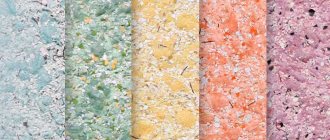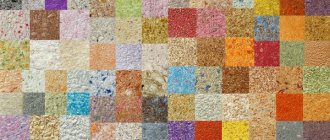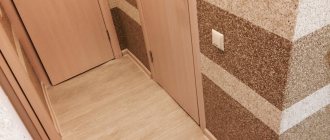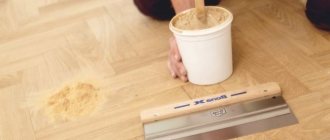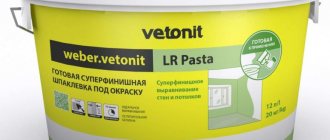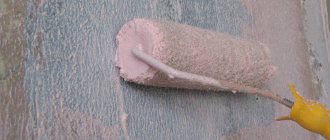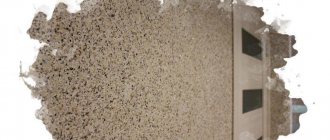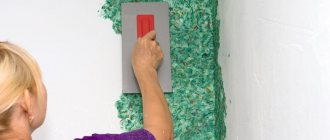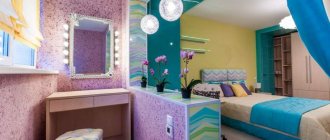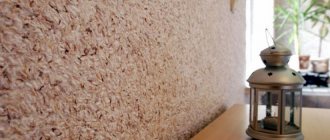Liquid wallpaper appeared on the domestic market relatively recently. In appearance, they are similar to paper-based canvas with a fabric structure. The color palette of the coating has virtually no limits. A distinctive feature is the ability to mix different colors, forming unique and original colors.
The canvas is made from natural ingredients, so there is no need to worry about environmental friendliness. Thus, the main production products are cotton and cellulose, often with the addition of lavsan.
Liquid wallpaper: concept, properties, description
Liquid wallpaper is a dry mixture that can be of different shades; the composition may contain far from identical components. The closest relatives of this type of finish are decorative plaster or standard paper wallpaper.
Diluted liquid wallpaper on the wall Source claso.ru
The consistency of liquid wallpaper in a diluted state resembles plaster compositions. They are applied to a spatula, and then simply distributed over the wall. This finishing option includes the following elements:
- fiber filler (it can be cotton or cellulose);
- adhesive composition (necessary as a binder);
- dye;
- various decorative components (Lurex, sparkles, threads, granules, shavings and others).
This material also differs from different types of plasters in that it does not contain sand. With the help of such a composition it is easy to correct defects made on the wall during repairs: you can always hide damaged areas.
On a note! Adding a special color will allow you to create an individual desired shade that will highlight the intended design solution.
Even a person who has no construction experience can cope with diluting this composition before applying it to the wall, since the cladding process does not cause any difficulties.
Options for liquid wallpaper in packaging and what they look like on the wall Source kraski-net.ru
Properties of liquid wallpaper
Any building material has individual properties, which are also taken into account when choosing. The physical characteristics of liquid wallpaper are as follows:
- vapor permeability - 120 m3/ms*Pa (this indicates that this mixture can be safely used for walls made of aerated concrete);
- noise absorption - no more than 30% when sounds of no more than 5 kHz appear;
- thermal conductivity - 0.04 W/mS.
From these characteristics it can be understood that liquid wallpaper plays a purely decorative role and, accordingly, cannot become even the slightest part of thermal insulation.
On a note! Experts do not recommend applying liquid wallpaper to uninsulated walls. Fungus or mold can grow on them in unventilated spaces.
Care and methods for restoring damaged areas
Surely many people have a number of questions: What is important to consider when leaving? How to restore the original appearance if the area is damaged?
Experts make several recommendations:
- To protect against moisture, liquid wallpaper is coated with a specialized colorless varnish. In this case, wet cleaning will be possible.
- It is better to clean with a vacuum cleaner or a dry cloth when dirty or once every 3-4 weeks;
- We use a magnetized brush that attracts dust.
The main advantages of liquid wallpaper
Liquid wallpaper can be found in wall cladding in modern interiors; their use is justified by a number of positive characteristics. This:
- environmentally friendly material, accordingly, is used with great success in children's rooms and public buildings;
- is fireproof due to the presence of binding components that are included in the dry mixture;
- forms perfectly smooth coatings, excluding bumps and seams, which are essential when gluing paper or vinyl wallpaper;
- there is no need to perfectly prepare and level the surface before applying the material, since all defects will be hidden behind the structure of the liquid wallpaper;
- shows its properties well when filling gaps between walls and baguettes (plinths);
- suitable for application to various materials, as it has good adhesion with most building compounds;
- the surface is resistant to high temperatures, as well as changes, and can withstand any vibration loads;
- the material is easy to apply and does not require special plastering skills or relevant experience;
- Over time, the coating does not fade, even with regular exposure to sunlight on the surface.
However, among the large list of advantages of facing material, there was also a significant disadvantage - the high price.
The presence of decorative components in finished liquid wallpaper Source baraholka.com.ru
Photos in the interior
Decor with liquid wallpaper is appropriate in residential buildings and public buildings.
The combination of high aesthetic qualities allows the use of such finishing in the interior of the living room.
Due to its environmental friendliness and maintainability, the material is ideal for children's rooms.
Liquid wallpaper for the bedroom can be decorated with elegant, stylish designs or ornaments.
Thanks to the wide range of colors and variety of design solutions, you can choose a finishing option for any interior.
Types of liquid wallpaper
Liquid wallpaper is usually classified into several types, each of which has its own qualities and properties. We propose to dwell on each of them separately:
- Cellulose. They contain waste produced during the woodworking process. This version of the material is often called paper and is tried to be used for cold, unheated rooms. At the same time, the surfaces themselves can be painted and, if necessary, restored. Their price is slightly lower compared to other options.
- Silk. The composition includes silk fibers, which provide the coating with an interesting “lively” shine. In addition to natural fabric, liquid wallpaper for walls also contains artificial silk, as well as additional decorative inclusions.
- Cotton. This material contains 100% cotton components. They occupy up to 98% of the total dry mass, and the rest is binders, as well as textile components and decorative inclusions. This coating dries successfully within two days. As a result, it has a rough surface with a velvet or matte tint.
- Combined. These include cellulose fibers, silk and others. Such a composition cannot do without decorative components - sparkles, colored thin threads and others. They can have an interesting gradient or marble shade. The range of palettes is quite wide. But such mixture options will cost slightly more than usual. The application method is the same for everyone.
The following types of liquid wallpaper are also popular: smooth and rough. We propose to dwell on their features:
- smooth ones are applied perfectly the first time, they are easier to care for, they are not dust collectors;
- embossed (rough) ones are more demanding in preparing the base, since large enough defects will simply spoil the relief of the dried wallpaper layer.
Video description
How to apply liquid wallpaper to a wall video.
The practice of combining smooth and embossed liquid wallpaper is allowed, for example, for zoning walls. Such a combination will also create an additional design effect if the cladding is properly organized.
Types of fillers in the mixture for preparing liquid wallpaper Source kerch.reklama-crimea.com
Paintable liquid wallpaper
Liquid wallpaper for painting is another convenient material that provides a base for further application of paint. The dry mixture of this type of wallpaper contains no dye, glitter or other additives. Basically, such compositions are made entirely of paper.
After applying this composition to the walls, wait until it hardens completely and only then paint the surface. As for the variety of paints, they try to choose a special one for wallpaper. Coloring is done in several layers, depending on the desired color intensity.
Floor coverings
To imitate brick in floor coverings, a concrete mixture and a special stencil are used. A stencil imitating masonry is applied to freshly laid concrete and rolled with a special roller. The coloring compound is rubbed into the slightly hardened concrete.
To reliably reproduce brickwork on the floor, clinker floor tiles are used, which are particularly durable and abrasion-resistant.
The technology for laying clinker tiles on the floor is no different from laying tiles made from other materials.
Preparing substrates for applying liquid wallpaper: useful little things
Despite the fact that the advantages indicate that surface preparation before application is not necessary, it will still be necessary to make it as suitable as possible for this material. In some cases, the preparation method may differ, since it all depends on the type of base.
Plasterboard surface
If the walls in the room are leveled with plasterboard, all that needs to be done is to putty all the unevenness, level the joints and seams, and cover up the dents at the fastening points before applying liquid wallpaper.
Application of liquid wallpaper on prepared plasterboard walls Source magazin-polzy.ru
Next, the coating should be primed and covered with water-dispersed paint, and if once before the surfaces of the drywall were in even the slightest contact with moisture, then they need to be covered with a thin layer of oil paint so that in the future it will not appear on the wallpaper if it remains in the layers of the wall.
On a note! When preparing plasterboard surfaces, do not limit yourself to just filling up the holes from drilling, because after applying the mixture, stripes of joints may appear, which will be visible even after the liquid wallpaper has dried.
Multi-color liquid wallpaper on a prepared plasterboard surface Source sotdelkoi.ru
Concrete base
If there is nothing on the wall other than concrete monolithic slabs, then you should first plaster it and try to remove defects, chips, and repair cracks. Additionally, you can putty the base.
Before applying liquid wallpaper to the surface of a concrete wall, it is carefully primed to ensure better adhesion. It is desirable that this composition penetrates into the base. The next step is to paint the wall in three layers of water-based paint.
Liquid wallpaper on a prepared concrete wall, applied without defects Source silkplaster.pl
Walls in old apartment buildings are prepared in a similar way. This is done to prevent the appearance of various stains and drips on the wallpaper that may form during the use of a wall with a clean finish.
On a note! If parts of rusted reinforcement are visible on concrete walls, be sure to thoroughly treat these places with an anti-corrosion compound, and then cover them well with plaster.
In addition to the listed surfaces, liquid wallpaper can be applied to putty, plastered, painted, brick and wooden substrates.
Imitation tiles
Reproduction of masonry with facing tiles made of gypsum, polystyrene foam, tile adhesive, ceramics, and PVC panels are popular and look authentic.
Decorative gypsum bricks
Decorative gypsum bricks can be easily made with your own hands if you first make a mold for the tiles.
First step: making the mold
To make the mold you will need a sheet of moisture-resistant plywood and several slats. The slats are stuffed onto the edges of a sheet of plywood, forming a tray into which the gypsum solution will be poured. From slats with a cross-section of 1×1 cm, a lattice is made with cells the size of a brick 250×65 mm. The lattice is placed over the mortar in the tray to form bricks. To reuse the mold, place plastic film on the bottom of the tray before pouring the mixture, and paint the wooden lattice with oil or alkyd enamel.
To make bricks from gypsum, you can purchase a ready-made silicone mold.
Second step: preparing the solution
To make imitation bricks, gypsum mortar is diluted to the consistency of sour cream. Dyes can be added to the solution, and for each batch of the solution the color can be slightly changed. The resulting tiles can be easily processed with a chisel or a sharp knife: sharp corners are smoothed out and the texture of the front surface of the tile is imparted.
Third step: cladding
The resulting bricks are used to cover the wall using a gypsum glue solution for good adhesion. To make the seams uniform, use slats or special crosses.
After the glue has set, the crosspieces or slats are removed, and the seams are filled with fugue and embroidered.
How to prepare material for work
When the walls are dealt with, it’s time to start mixing the dry mixture. This process should take approximately 10-12 hours. It is not recommended to leave the composition for a long time, as it can harden and applying it to a vertical surface will be problematic.
- Prepare a deep container in which it will be convenient to mix the composition of liquid wallpaper for walls. Try to choose exclusively a plastic product for this purpose, so that oxidation does not occur, for example, when mixing the composition in metal basins.
- Pour all the ingredients from one package into it (more often they are already sold mixed in one large bag, which eliminates the need for mixing).
- After pouring the mixture into a container, thoroughly fluff it up so that it is enriched with oxygen, then add water in small portions and begin mixing the composition with your hands, wearing rubber gloves.
- Add warm water (30-35 degrees) as needed. The result should be a medium-thick consistency that is easy to apply. Stir the material for at least 15 minutes.
- Then make sure that all components are completely wetted with water. After this, just leave the product for 10-12 hours to swell.
Mixing liquid wallpaper in a bucket manually Source stucco-club.ru
Basics of applying liquid wallpaper to a surface
To decorate walls with liquid wallpaper, prepare several tools: a plaster float, a spatula, a trowel. Next, do everything according to a simple short algorithm:
- apply the pre-prepared composition to a trowel or spatula (just don’t overdo it, add a little at a time);
- take the tool so that when it comes into contact with the wall, an angle of 15 degrees is formed;
- distribute the mixture evenly over a small fragment of the wall from the ceiling downwards;
- Observe the layer thickness during each application; it should not exceed 3 mm.
Please note that the mixture may be quite thick. This will prevent its normal distribution along the wall, as it will roll off. In this case, it is allowed to add a small amount of water to dilute the composition, but not more than 500 grams.
Applying liquid wallpaper to the wall using a spatula Source stenaprofi.ru
On a note! Soaking the dry mixture is carried out in the same way, regardless of the type of liquid wallpaper.
Designing a wall using liquid wallpaper Source decorstena.ru
Features of applying drawings and patterns
One of the reasons for the particular popularity of finishing is the ability to create drawings, patterns, appliqués and artistic compositions. It is easy to combine with other finishing coatings.
You can apply designs to liquid wallpaper with your own hands using stencils. For these purposes, it is better to purchase reusable stencils made of polymer film or cover homemade paper ones with tape. First you need to fix the stencil on the prepared and primed wall. Distribute the wallpaper mass in the slots of the stencil, observing the specific direction of movement of the grater. After the drawing has dried, fill in the remaining sections of the wall.
When drawing an image from a sketch, first a drawing is drawn on the wall with a pencil, the outline and small details are drawn. Within the contours of individual elements of the pattern, a working solution is applied and distributed using a trowel. First, non-adjacent elements of the picture are filled. After they dry, the remaining areas are filled.
This makes it easy to create geometric patterns.
